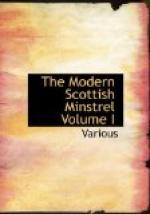[20] From Albyn’s “Anthology,” vol. i. p. 42. Edinburgh, 1816, 4to.
JOHN MAYNE.
John Mayne, chiefly known as the author of “The Siller Gun,” a poem descriptive of burgher habits in Scotland towards the close of the century, was born at Dumfries, on the 26th of March 1759. At the grammar school of his native town, under Dr Chapman, the learned rector, whose memory he has celebrated in the third canto of his principal poem, he had the benefit of a respectable elementary education; and having chosen the profession of a printer, he entered at an early age the printing office of the Dumfries Journal. In 1782, when his parents removed to Glasgow, to reside on a little property to which they had succeeded, he sought employment under the celebrated Messrs Foulis, in whose printing establishment he continued during the five following years. He paid a visit to London in 1785, with the view of advancing his professional interests, and two years afterwards he settled in the metropolis.
Mayne, while a mere stripling, was no unsuccessful wooer of the Muse; and in his sixteenth year he produced the germ of that poem on which his reputation chiefly depends. This production, entitled “The Siller Gun,” descriptive of a sort of walkingshaw, or an ancient practice which obtained in his native town, of shooting, on the king’s birth-day, for a silver tube or gun, which had been presented by James VI. to the incorporated trades, as a prize to the best marksman, was printed at Dumfries in 1777, on a small quarto page. The original edition consisted of twelve stanzas; in two years it increased to two cantos; in 1780, it was printed in three cantos; in 1808, it was published in London with a fourth; and in 1836, just before his death, the author added a fifth. The latest edition was published by subscription, in an elegant duodecimo volume.
In 1780, in the pages of Ruddiman’s Weekly Magazine, Mayne published a short poem on “Halloween,” which suggested Burns’s celebrated poem on the same subject. In 1781, he published at Glasgow his song of “Logan Braes,” of which Burns afterwards composed a new version.
In London, Mayne was first employed as printer, and subsequently became joint-editor and proprietor, along with Dr Tilloch, of the Star evening newspaper. With this journal he retained a connexion till his death, which took place at London on the 14th of March 1836.
Besides the humorous and descriptive poem of “The Siller Gun,” which, in the opinion of Sir Walter Scott, surpasses the efforts of Ferguson, and comes near to those of Burns,[21] Mayne published another epic production, entitled “Glasgow,” which appeared in 1803, and has passed through several editions. In the same year he published “English, Scots, and Irishmen,” a chivalrous address to the population of the three kingdoms. To the literary journals, his contributions, both in prose and verse, were numerous and interesting. Many of his songs and ballads enriched the columns of the journal which he so long and ably conducted. In early life, he maintained a metrical correspondence with Thomas Telford, the celebrated engineer, who was a native of the same county, and whose earliest ambition was to earn the reputation of a poet.[22]




